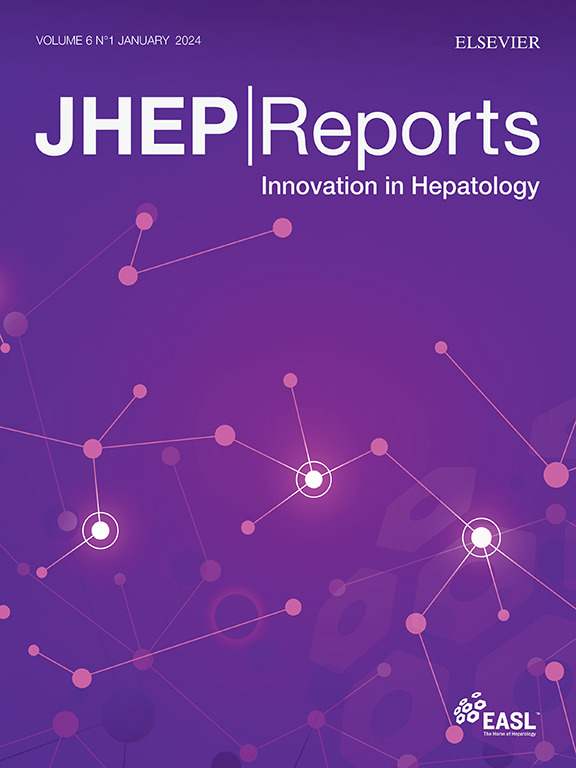Identification of pediatric MASLD using insulin resistance indices
IF 7.5
1区 医学
Q1 GASTROENTEROLOGY & HEPATOLOGY
引用次数: 0
Abstract
Background & Aims
We investigated the triglyceride-to-high density lipoprotein (HDL) ratio (TG/HDL), triglyceride–glucose index (TyG), single-point insulin sensitivity estimator (SPISE), and metabolic score for insulin resistance (METS-IR) as potential predictors of pediatric metabolic dysfunction-associated steatotic liver disease (MASLD) by addressing the limited research on insulin-resistance markers in this population.
Methods
This cross-sectional study included data from 1,150 and 260 youths from the National Health and Nutrition Examination Survey (NHANES) and a real-world clinic, respectively. Hepatic steatosis was assessed using transient elastography and abdominal sonography. Logistic regression analysis was performed using MASLD as the dependent variable. Receiver operating characteristic (ROC) curves were used to evaluate predictability.
Results
The MASLD group had higher TG/HDL, TyG, METS-IR, and obesity proportions but lower SPISE than the normal group in both NHANES and real-world data. All markers were significantly related to MASLD in logistic regression analyses, even after adjusting for age and sex, in both the NHANES and real-world clinic data (all p <0.001). The areas under the ROC curves (AUCs) for SPISE and METS-IR were 0.91 and 0.91 in the total group, 0.92 and 0.92 in the male group, and 0.90 and 0.89 in the female group, respectively—all higher than those for TG/HDL and TyG in the NHANES dataset (all p <0.001). In the real-world clinical data, the AUCs of SPISE and METS-IR were significantly higher than those of TG/HDL and TyG in the total and male groups (all p <0.001). In the female group, the AUC for SPISE was significantly higher than that for TG/HDL or TyG.
Conclusions
METS-IR and SPISE are effective, non-invasive markers for predicting pediatric MASLD, which offer valuable tools for early detection and improved clinical management.
Impact and implications
The increasing prevalence of pediatric metabolic dysfunction-associated steatotic liver disease (MASLD) and its strong association with cardiometabolic risk factors underscore the need for effective early detection tools. Our study demonstrates that single-point insulin sensitivity estimator (SPISE) and metabolic score for insulin resistance (METS-IR) are superior, non-invasive markers for predicting MASLD in children and adolescents, with validated cut-off values applicable to both population-based and real-world clinical settings. These findings are particularly relevant for clinicians and healthcare policymakers, as they provide practical, easily accessible screening tools derived from routine laboratory tests, aiding in the early identification and risk stratification of pediatric MASLD. However, given the study’s retrospective design and variations in diagnostic methods across datasets, further validation in larger, diverse cohorts is warranted to refine age-specific cut-off values and optimize screening approaches.

应用胰岛素抵抗指标鉴别小儿MASLD
背景,目的:我们研究甘油三酯/高密度脂蛋白(HDL)比值(TG/HDL)、甘油三酯-葡萄糖指数(TyG)、单点胰岛素敏感性估计值(SPISE)和胰岛素抵抗代谢评分(METS-IR)作为儿科代谢功能障碍相关脂肪性肝病(MASLD)的潜在预测因子,解决该人群中胰岛素抵抗标志物的有限研究。方法本横断面研究包括来自国家健康与营养调查(NHANES)和现实世界诊所的1150和260名青少年的数据。肝脂肪变性评估采用瞬时弹性成像和腹部超声。以MASLD为因变量进行Logistic回归分析。受试者工作特征(ROC)曲线用于评估可预测性。结果在NHANES和实际数据中,MASLD组的TG/HDL、TyG、METS-IR和肥胖比例均高于正常组,但SPISE低于正常组。在逻辑回归分析中,即使在调整了年龄和性别之后,在NHANES和现实世界的临床数据中,所有标记物都与MASLD显著相关(均p <;0.001)。SPISE和met - ir的ROC曲线下面积(auc)在总组为0.91和0.91,男性组为0.92和0.92,女性组为0.90和0.89,均高于NHANES数据集中的TG/HDL和TyG(均p <;0.001)。在实际临床数据中,SPISE和met - ir的auc在总数组和男性组中均显著高于TG/HDL和TyG (p <0.001)。在女性组中,SPISE的AUC显著高于TG/HDL或TyG。结论met - ir和SPISE是预测儿童MASLD的有效、无创标志物,为早期发现和改善临床管理提供了有价值的工具。影响和意义儿童代谢功能障碍相关脂肪变性肝病(MASLD)患病率的增加及其与心脏代谢危险因素的强烈关联强调了对有效早期检测工具的需求。我们的研究表明,单点胰岛素敏感性估计值(SPISE)和胰岛素抵抗代谢评分(METS-IR)是预测儿童和青少年MASLD的优越的非侵入性标志物,具有有效的临界值,适用于基于人群和现实世界的临床环境。这些发现对临床医生和卫生保健决策者特别重要,因为它们提供了实用的、易于获得的来自常规实验室检查的筛查工具,有助于儿童MASLD的早期识别和风险分层。然而,考虑到该研究的回顾性设计和不同数据集的诊断方法的差异,需要在更大、更多样化的队列中进一步验证,以完善特定年龄的临界值和优化筛查方法。
本文章由计算机程序翻译,如有差异,请以英文原文为准。
求助全文
约1分钟内获得全文
求助全文
来源期刊

JHEP Reports
GASTROENTEROLOGY & HEPATOLOGY-
CiteScore
12.40
自引率
2.40%
发文量
161
审稿时长
36 days
期刊介绍:
JHEP Reports is an open access journal that is affiliated with the European Association for the Study of the Liver (EASL). It serves as a companion journal to the highly respected Journal of Hepatology.
The primary objective of JHEP Reports is to publish original papers and reviews that contribute to the advancement of knowledge in the field of liver diseases. The journal covers a wide range of topics, including basic, translational, and clinical research. It also focuses on global issues in hepatology, with particular emphasis on areas such as clinical trials, novel diagnostics, precision medicine and therapeutics, cancer research, cellular and molecular studies, artificial intelligence, microbiome research, epidemiology, and cutting-edge technologies.
In summary, JHEP Reports is dedicated to promoting scientific discoveries and innovations in liver diseases through the publication of high-quality research papers and reviews covering various aspects of hepatology.
 求助内容:
求助内容: 应助结果提醒方式:
应助结果提醒方式:


